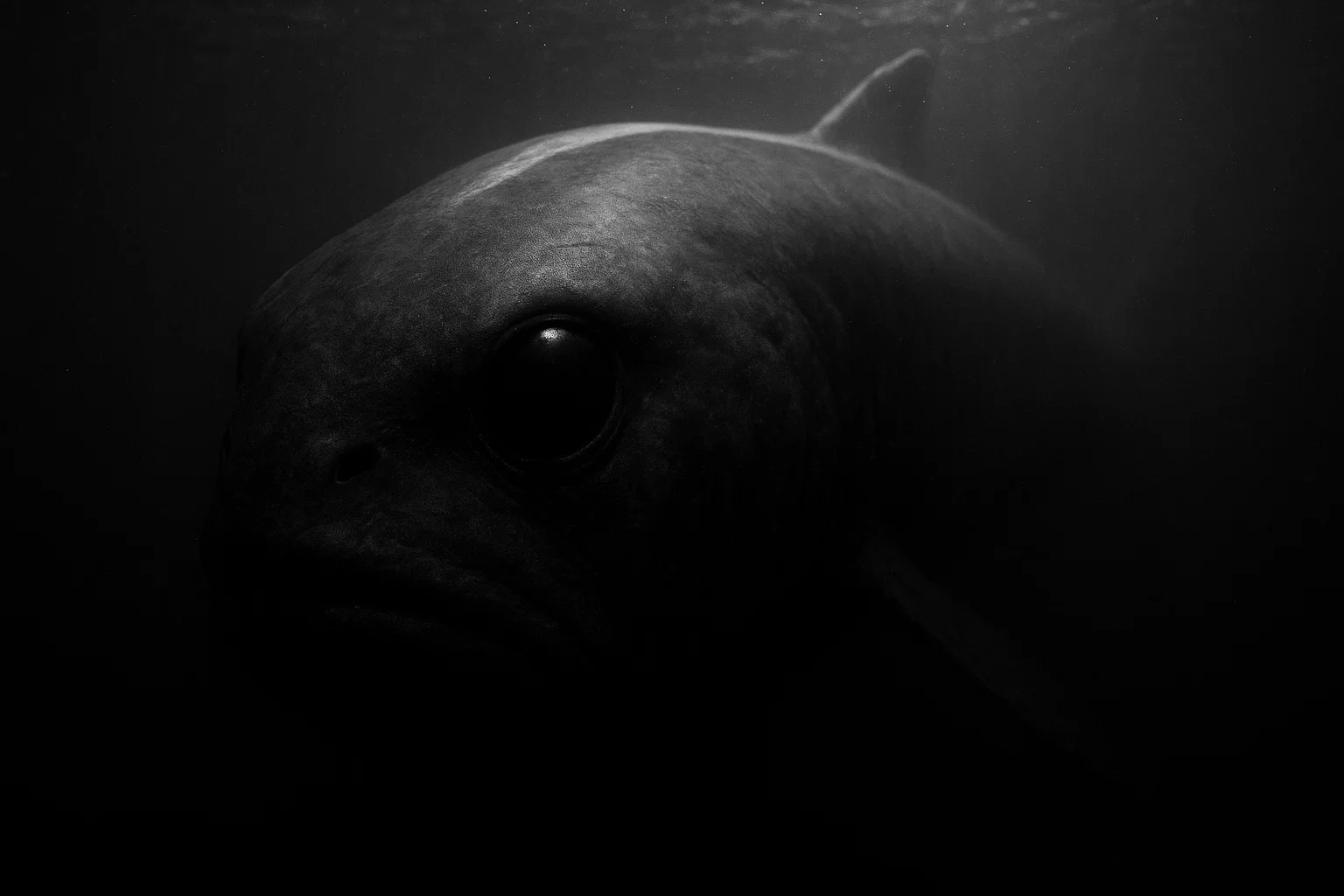The Lake Iliamna Monster is a cryptid reported in Alaska’s largest freshwater lake. Known locally as Illie, this evasive aquatic cryptid has been part of native folklore for centuries. It has gained modern attention through sightings by pilots and fishermen.
Descriptions portray it as a massive fish-like being, sparking debates on its existence. Despite investigations, no concrete evidence has confirmed that the cryptid is real, leaving the mystery enduring in Alaskan culture.
Summary
Overview
| Attribute | Details |
|---|---|
| Name | Lake Iliamna Monster |
| Aliases | Illie, Gonakadet, Jig-ik-nak |
| Threat Level | Aggressive |
| Habitat | Freshwater lake, remote Alaskan wilderness |
| Physical Traits | 10–30 feet long, dull aluminum color, broad blunt head, tapered body, vertical tail, 6–8 feet wide |
| Reported Sightings | Pedro Bay, Kakhonak village, Iliamna village, unnamed islands in Lake Iliamna |
| First Documented Sighting | Early 19th century (native reports), 1942 (modern) |
| Species Classification | Unknown |
| Type | Aquatic |
| Behavior & Traits | Elusive, nocturnal, aggressive ramming of boats, group travel |
| Evidence | Eyewitness accounts, damaged equipment |
| Possible Explanations | Misidentified sturgeon, sleeper shark |
| Status | Ongoing mystery |
Who or What Is the Lake Iliamna Monster?
The Lake Iliamna Monster is a large, unidentified creature said to inhabit Lake Iliamna in southwestern Alaska. Native Tlingit and Aleut peoples have long told stories of similar beings, such as the Gonakadet, a fish god with a wolf-like head and orca body that protected or threatened communities.
Modern reports began in the mid-20th century, mainly from pilots flying over the lake who spotted enormous fish-like forms below the surface. Fishermen have also encountered it, describing incidents in which boats were rammed or a powerful underwater force destroyed equipment.
The creature remains unclassified, with no captures or clear photographs. Still, consistent accounts suggest a bottom-dwelling animal that rarely surfaces.
Your Personalized, Hyper Accurate Moon & Astrology Reading
Limited time offer: Get your FREE, fully personalized Moon & Astrology Reading that takes astrology to a whole new level. Discover the secret depths of your personality, relationships, and true purpose in life.
What Does the Lake Iliamna Monster Look Like?
Accounts of the Lake Iliamna Monster depict it as a massive aquatic animal measuring 10 to 30 feet in length.
Witnesses describe a body with a dull aluminum hue, sometimes shifting to dark grey or brown, and a broad, blunt head shaped squarely for potential ramming. The head matches the body’s width, resulting in a long, tapered form that ends in a vertical tail that moves side to side like a fish.
Some reports note a large black coloration with a prominent white stripe along the dorsal fin. Eyes are said to be as large as soccer balls in certain encounters.
Unlike whales, it lacks blowholes and does not surface regularly for air. Additional traits include smooth skin without scales in some descriptions, and an overall submarine-like silhouette when viewed from above. Size estimates vary, with some sightings of creatures exceeding 50 feet, often accompanied by smaller individuals.
Habitat
Lake Iliamna serves as the primary habitat for the alleged monster, spanning 77 miles in length and 22 miles in width in southwestern Alaska.
This remote body of water reaches depths of 988 feet, with an average of 144 feet, creating vast unexplored areas ideal for large aquatic life. The lake sits about 50 feet above sea level. It is connected to Bristol Bay via the Kvichak River, allowing marine species such as beluga whales and seals to enter during migrations.
The surrounding terrain includes rugged wilderness with sparse vegetation, tundra, and forested shores, influenced by a subarctic climate with long winters and short summers. Temperatures drop below freezing for months, icing the surface and limiting access.
Fauna consists of sockeye salmon runs, rainbow trout, northern pike, and seals, providing ample prey. Human settlements are sparse, with small villages such as Iliamna, Pedro Bay, and Kakhonak relying on subsistence fishing and hunting.
Floatplanes offer the main transportation, as no roads connect the area, preserving its isolation and fostering legends of hidden creatures in the depths.
You May Also Like: What Is a Pukwudgie? Spirit, Cryptid, or Something Worse?
Lake Iliamna Monster Sightings
| Date | Place | Witness Details | Description | Reliability |
|---|---|---|---|---|
| Pre-1800s | Lake Iliamna shores | Tlingit and Aleut natives | Large fish-like monsters attacking canoes, killing warriors, wolf-like head and orca body | Medium: Oral traditions |
| 1942 | Near unnamed island in Lake Iliamna | Pilots Babe Alyesworth and Bill Hammersley | Dozens of giant fish over 10 feet long, dull aluminum color, broad heads, tapered bodies, vertical tails waving side to side | High: Multiple witnesses |
| 1945 | Across Lake Iliamna | Pilot Larry Rost | Giant fish over 20 feet long, dull aluminum color | Medium: Single witness |
| 1963 | Overhead in Lake Iliamna | Unnamed biologist | 25–30 foot fish, did not surface for air over 10 minutes | Medium: Professional observer |
| 1967 | Lake Iliamna, from floatplane | Missionary Chuck Crapuchettes | Large animal sighted from floatplane | Medium: Single witness |
| 1967 | Lake Iliamna, near floats | Friend of Chuck Crapuchettes | Trolling cable jerked, plane towed, cables gone, hooks straightened | High: Physical damage evidence |
| 1977 | Pedro Bay in Lake Iliamna | Pilot Tim LaPorte and two passengers | 12–14 foot fish on surface, dived with arching splash, vertical tail, dark grey or brown skin | High: Multiple witnesses |
| 1979 | Lake Iliamna | Fishermen | Boats rammed by unknown creature | Medium: Multiple reports |
| 1987 | Lake Iliamna | Resident Verna Kolyaha | Large black fish with white stripe down its fin | Low: Single witness |
| 1988 | Near surface in Lake Iliamna, near Iliamna village | Several locals, from boat and shore | Large black fish with fin swimming near surface | Medium: Multiple witnesses |
| 2017 (June 19) | Offshore near Iliamna village | Local kids | Creature size of large whale | Low: Youth witnesses |
| 2017 (June) | Near Kokhanok village | Village residents including Gary Nielsen | Three large creatures, largest double size of 32-foot gillnetter, puzzling disturbance in water | High: Multiple witnesses |
| 2017 | About a mile offshore Kokhanok | Roy Andrew | Fins standing 8 feet high, swimming toward shore on calm day, sank into deep water | Medium: Single witness |
| 2017 | About a mile offshore from Kakhonak village | Kakhonak village residents | 50–60 foot creature blowing like whale, with smaller ones following along behind it | Medium: Multiple witnesses |
| 2020 | Lake Iliamna | Unnamed witnesses | Three separate sightings of monsters, no specific details | Low: Undetailed reports |
| Undated | Kvichak River | Various witnesses | Large creatures, possibly traveling to/from Bering Sea | Low: No specifics |
| Undated | Lake Iliamna | Gary Nielsen | Numerous cryptic creatures, rock-colored like freshwater rays, monsters with tree-like appendages | Medium: Experienced fisherman |
| Undated | Lake Iliamna | Various locals | Large fins in the water | Low: General reports |
Babe Alyesworth and Bill Hammersley (Lake Iliamna, 1942)
In September 1942, pilots Babe Alyesworth and Bill Hammersley were flying a Stinson ferry plane over Lake Iliamna en route to Iliamna village.
At around 1,000 feet in altitude, they noticed unusual specks in the water near an unnamed island. They decided to spiral down to 300 feet for a better view. They observed dozens of giant fish, each longer than 10 feet—exceeding the length of their plane’s pontoons.
The creatures had dull, aluminum-colored skin, broad, blunt heads the same width as their bodies, long, tapered forms, and vertical tails that waved side to side like fish, not up and down like mammals. They circled the area, watching the animals move in a submarine-like manner before surging and disappearing underwater without surfacing for air like whales.
This sighting, one of the first well-documented modern accounts, ruled out known species such as whales due to the tail movement and lack of blowholes, sparking widespread interest and encouraging others to report similar encounters.
Awaken XT is unlike anything you’ve ever tried before…
…it’s based off a closely guarded formula that’s said to be able to supercharge your pineal gland and help you access your untapped inner power. With it’s unique blend of extremely hard to source ingredients, Awaken XT helps support the healthy functioning of your pineal gland, as well as your other organs in your body.
Chuck Crapuchettes (Lake Iliamna, 1967)
Alaska missionary and pilot Chuck Crapuchettes reported two separate encounters in 1967. First, while flying over the lake in his floatplane, he spotted a large animal in the water. He radioed nearby people to verify, but no one arrived in time.
In the second incident, a friend attempted to troll for the creature using a 5/16-inch stainless steel cable with #2 tuna hooks baited with caribou meat, tied to the plane’s struts. While drifting and sitting on the floats, the plane suddenly jerked violently, knocking the friend into the water.
The aircraft was towed around the lake for miles as the friend swam to shore and walked to recover it. Upon retrieval, three cables were missing, and the remaining hooks—eight or nine inches long—were completely straightened out.
This physical evidence of immense force suggested something far stronger than typical lake fish, such as pike or salmon, aligning with native tales of aggressive water beings and supporting theories of a large predator capable of damaging equipment.
You May Also Like: The Nimerigar: Cannibalistic Little People of the Rocky Mountains
Tim LaPorte (Pedro Bay, 1977)
In 1977, veteran pilot Tim LaPorte, accompanied by two passengers, including a visiting Michigan fish and game official, was flying over Pedro Bay at the northern tip of Lake Iliamna.
They spotted a 12–14-foot fish resting on the surface with dark grey or brown skin. As the plane approached, the creature dove straight down, creating a large arching splash that revealed its vertical tail moving side to side. The group watched as it sounded deeper into the water, its movements distinct from marine mammals.
This aerial observation from multiple witnesses, including a professional in wildlife management, reinforced patterns seen in earlier pilot reports, such as the aluminum coloration variations and fish-like propulsion.
Kakhonak Village Residents (Kakhonak, 2017)
In 2017, residents of Kakhonak village witnessed a remarkable event about a mile offshore.
Multiple adults and children, some using binoculars, observed a 50–60-foot creature that blew air like a whale, accompanied by smaller individuals trailing behind, creating significant water disturbance. This mass sighting stood out for the number of observers who agreed on details, including the blowing action and group formation, which echoed native stories of herding or family units.
Local fisherman Gary Nielsen, with extensive experience on the lake, described the largest as double the size of a 32-foot gillnetter, emphasizing its immense scale.
The event resurfaced interest in the legend, prompting discussions on whether it could be migrating marine animals or an unknown species, and added to a cluster of 2017 reports that included similar disturbances near Kokhanok, suggesting possible increased activity or better reporting in the area.
Evidence & Investigations
The Lake Iliamna Monster is a mysterious creature that people have been reporting sightings of for many years.
Eyewitness accounts come from a mix of pilots, fishermen, and residents who all describe a creature with shiny, aluminum-colored skin and a vertical tail. However, despite these descriptions, no one has been able to capture clear photos or find any physical evidence of the monster.
Some indirect signs, like damaged fishing gear, have supported the stories. For example, bent fishing hooks, broken fishing lines, and marks left on boats suggest that something very strong might be out there. One notable incident in 1967 involved straightened hooks, indicating an incredible amount of power.
Another event in 2019 saw an underwater camera set up to capture footage. However, the camera was destroyed after a mysterious creature attracted to the bait drained the battery and wrecked the equipment.
Over the years, various investigations have taken place to find the creature. In 1959, a man named Tom Slick funded an aerial search in hopes of spotting it, but nothing was seen. In 1979, the Anchorage Daily News even offered a $100,000 reward for anyone who could provide definitive proof of the monster, but no one claimed the prize.
More recently, in 2017 and 2019, marine biologist Bruce Wright and retired colonel Mark Stiger conducted their own research. They used special fishing gear with salmon as bait.
They found that the anchors had been dragged over 50 yards and the fishing snaps had been twisted, suggesting that whatever was out there was stronger than usual fish, such as halibut. Their attempts at underwater filming didn’t work out, so they focused on observing without causing much disturbance.
The Lake Iliamna Monster has caught the attention of television shows as well. Programs like Animal Planet’s River Monsters and the History Channel’s Missing in Alaska featured stories and interviews, including one from kayaker John Chamberlain, who recounted a frightening encounter in which his paddle was bitten and his kayak was struck.
On the show, biologist Jeremy Wade discussed possible explanations for the unusual encounters. Still, the mystery of the Lake Iliamna Monster remains unsolved.
You May Also Like: What Are the Teihiihan—the Cannibal Dwarves of the Great Plains?
Theories
White Sturgeon
One popular idea about the monster is that it might be a white sturgeon, which is the largest fish found in North America’s freshwater. These massive fish can grow over 20 feet long and weigh as much as 1,500 pounds!
They have tough, armor-like skin that might explain reports of boat propellers getting damaged and incidents where something seems to hit boats, as their bony plates could leave behind marks that look like tooth impressions.
White sturgeons usually stay near the bottom of rivers and lakes and rarely come to the surface, which is why people don’t often see them, despite how large Iliamna Lake is.
These fish travel through rivers like the Kvichak and might enter the lake when salmon are swimming upstream. Plus, they can live a very long time—up to 100 years—so large sturgeons could be around for many generations.
Biologist Jeremy Wade, known from the show River Monsters, has looked into this theory and believes that the dull, gray color and powerful tails of the white sturgeon match descriptions of a creature reported to have a shiny, tapered shape and to move vertically in the water.
However, there’s no confirmed population of sturgeons in Iliamna Lake. Still, unknown groups may live in its deep waters, which are rich in food for them.
Sleeper Shark
One possible explanation for the mysterious sightings in the area points to a type of shark known as the Pacific sleeper shark. These sharks can grow quite large, reaching lengths of up to 23 feet, and are found in Alaskan waters, including around Bristol Bay.
What makes them particularly interesting is that they can swim into freshwater rivers, like the Kvichak River, especially when following seals to hunt for fish, such as salmon. This ties into when people report seeing these creatures, as it often coincides with the fish runs.
Pacific sleeper sharks are known for their dark grey skin, long cylindrical bodies, and powerful strength. This could explain reports of lost anchors or damaged fishing gear, as well as sightings of large, shadowy shapes in the water.
Because these sharks prefer deep waters and rarely come to the surface, encounters with them are quite rare, which might explain why there haven’t been many sightings of them catching their breath like typical fish do.
People who support this theory emphasize that sightings often occur around the same time as seals move into the area. Additionally, these sharks can tolerate fresh water, which suggests they may be found in places like Iliamna Lake.
In 2012, a video capturing a smaller sleeper shark nearby helped reinforce this idea, suggesting that much larger sharks could also be present, even if the reported sizes (like 50-60 feet) might be exaggerated or involve multiple sharks seen together.
You May Also Like: What Is Átahsaia, the Cannibal Demon of Zuni Mythology?
Beluga Whale
Some people have reported seeing what they believe are large creatures, such as beluga whales, entering the lake through rivers connected to the ocean, such as the Kvichak River.
Beluga whales travel in groups and surface to breathe, which can lead to confusion when observing them. In 2017, there were reports of a big creature making splashes and disturbances, which might have been misunderstood.
Belugas are usually white or grey and can grow up to 18 feet long. If someone sees them from a distance or in unclear conditions, they might misjudge their size. There have been strange events in the past, like the 1967 cable jerk, when it’s possible that belugas got caught in fishing gear. Normally, belugas have flat tails, while the stories mention creatures with tall, vertical tails, which doesn’t match.
Belugas often enter freshwater to give birth or to find food, which is possible in Iliamna because it connects to the ocean. However, these whales need to surface frequently, which contradicts reports from a biologist in 1963 who claimed to have observed a creature underwater for up to 10 minutes without surfacing.
Adapted Marine Predator
A tailored theory suggests an unknown or adapted marine predator, perhaps a variant of orca or wolf-fish hybrid from native lore, evolved for Iliamna’s unique ecosystem.
Tlingit tales of Gonakadet describe a wolf-headed, orca-bodied entity with intelligence for herding prey and territorial aggression toward boats. This could represent an undiscovered species or subspecies that migrated inland and adapted to freshwater, exhibiting group hunting, ramming behavior, and large fins or appendages, as reported in some cases, such as 8-foot fins or tree-like structures.
The lake’s isolation and depth could support speciation, with connections to the sea allowing occasional influx. Supporters point to consistent indigenous depictions and modern mass sightings of multiple creatures as evidence of a breeding population, potentially explaining varied descriptions through growth stages or sexual dimorphism.
Comparison with Other Similar Cryptids
| Cryptid | Location | Size | Description | Explanations |
|---|---|---|---|---|
| Loch Ness Monster | Loch Ness, Scotland | 20–30 ft | Long neck, humps, plesiosaur-like | Sturgeon, logs, hoaxes |
| Champ | Lake Champlain, USA/Canada | 10–20 ft | Serpentine, horse-like head | Large fish, seals |
| Ogopogo | Okanagan Lake, Canada | 40–50 ft | Multi-humped, snake-like | Sturgeon, oarfish |
| Nahuelito | Nahuel Huapi Lake, Argentina | 15–20 ft | Plesiosaur shape, humps | Giant eel, logs |
| Tahoe Tessie | Lake Tahoe, USA | 10–80 ft | Serpentine, fast swimmer | Large trout, debris |
| Bear Lake Monster | Bear Lake, USA | 40–60 ft | Serpent with legs, alligator head | Beaver, otters |
| Flathead Lake Monster | Flathead Lake, USA | 20–40 ft | Eel-like, brown | Sturgeon, waves |
| Cressie | Crescent Lake, Canada | 20–30 ft | Eel-shaped, dark | Giant eel |
| Manipogo | Lake Manitoba, Canada | 12–50 ft | Serpentine, humped | Moose, sturgeon |
| Memphre | Lake Memphremagog, USA/Canada | 30–50 ft | Long neck, humps | Large pike, illusions |
| Igopogo | Lake Simcoe, Canada | 12–70 ft | Dog-like head, fins | Seals, otters |
| Mussie | Muskrat Lake, Canada | 20–30 ft | Three eyes, finned | Sturgeon, logs |
You May Also Like: Who Is Aim in Demonology? The Demon Prince of Fire and Ruin
Is Lake Iliamna Monster Real?
The Lake Iliamna Monster remains a mystery, with many people reporting strange sightings and equipment getting damaged, suggesting something unusual is happening in the lake. Local Native American legends and modern-day stories add depth to its cultural significance, enriching Alaska’s folklore.
However, the absence of clear photographs, physical evidence, or confirmed captures leans toward more ordinary explanations, such as misidentified large fish, like sturgeon or even sharks. Investigations have produced interesting findings, but nothing has been proven, keeping the mystery alive.
While it’s unlikely that a creature from the past still exists, the idea of an undiscovered large fish is intriguing. It highlights our ongoing curiosity about the unexplored depths of the water.









